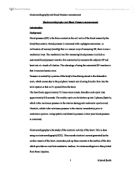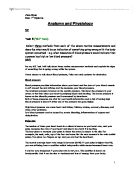An individual’s heart rate is most commonly measured by palpation. This is where a pulse is felt in order to obtain heart rate. The two most common measurement sites are over the radial (wrist) or the carotid arteries. (neck) Although the carotid artery is a very obtainable site, pressure on it can cause heart rate to drop in a reflex fashion. This makes the radial the preferred measuring point.
Blood pressure is the pressure exerted by the blood on the wall of the blood vessel. Blood pressure is generated by the contraction of the ventricles. (Beashel et al) There are three types of blood pressure. One type is systolic blood pressure. This provides an estimate of the work of the heart and the pressure against the arterial walls during ventricular systole. It is usually 110-145 mmHg. (Millimetres of mercury) Another type of blood pressure is diastolic blood pressure. This provides an indication of the peripheral resistance against which the blood must flow. It is usually 60-90 mmHg.
There is also the mean arterial pressure. This represents the average pressure exerted during the cardiac cycle. This is worked out using the equation:
MAP = diastolic + 1/3 (systolic – diastolic)
Blood pressure as a whole is determined by the equation:
Blood pressure = Flow x Resistance
The rate of blood flow depends upon cardiac output. Cardiac output is defined as the volume of blood pumped by each ventricle in one minute. (Davis, Bull, Roscoe, Roscoe 2000) Cardiac output has its own equation to describe it:
Cardiac output = Stroke volume x Heart rate
Stroke volume is the amount of blood pumped by the left ventricle of the heart in one contraction. Stroke volume could change when body posture does. This could be due to certain body positions requiring more energy than others. This could result in higher or lower stroke volume.
Cardiac output is also dependant on the amount of venous blood returning to the right side of the heart. This is known as venous return (Davis et al) during exercise, venous return increases, resulting in an increased cardiac output. This can be put down to Starling’s law of the heart which states the stimulus that causes greater force of contraction is the stretching of muscle fibres themselves (Davis et al) Posture could effect venous return, as it would be expected that blood would find it harder to return standing rather than lying, as the flow has to fight against gravity.
Resistance is caused by fluid friction between blood and walls of blood vessels. Resistance to blood flow within blood vessels is known as peripheral resistance and it depends on the viscosity, blood vessels length and blood vessel radius. (Davis et al)
Viscosity is a function of the friction between molecules of a flowing fluid. The greater the friction, the greater the viscosity. The two other determinants of resistance are the length and radius of the tube through which the fluid flows. These characteristics affect the surface area of the tube and therefore the amount of friction between the fluid and the wall of the tube. (Vander, Sherman 2004) The equation below defines the contribution of the three determinants:
Length x Viscosity / radius x 4
Blood pressure is measured by listening for korotokoff sounds in the artery whilst pressure around the cuff on the arm is decreased.
There have been other experiments which have looked at the effects of posture on heart rate and blood pressure. One experiment conducted at Yale University Connecticut looked at the effects of posture on cardiovascular responses. There results found that both heart rate and mean arterial blood pressure were lower in a supine position rather than an upright position. These are the results that are expected in this study.
Method
Participants: There were 26 participant’s involved in this study. They were a mixture of males and females. They were all volunteers and were undergraduates at Hull University. There was an average age of 20 +/- 1.
Apparatus: The apparatus used in the experiment were a stopwatch, a chair, a stethoscope, and a cuff manometer.
Procedure: After three minutes of rest, each participant’s heart rate was taken. This was performed by each participant palpating their radial pulse with their fingers. Another person would time thirty seconds on the stopwatch whilst the participant counted the number of beats. The number of beats was then doubled to record each participant’s heart rate. This was performed three times for each position, standing, seated, and supine.
After heart rate was measured, blood pressure was. The cuff was positioned on the participant so that the lower edge was about 2.5 cm above the centre of the elbow. The stethoscope diaphragm was positioned directly over the brachial artery in the antecubital space. The cuff was then inflated to 170 mmHg. After this the air pressure in the cuff was released slowly. The participant’s helper then had to make a mental note of the pressure reading as korotokoff sounds first appear (systolic pressure) and then disappear (diastolic pressure) Each participant’s score was recorded. Like for heart rate, this process was performed three times for each position.
Results
Figure 1 – Shows the mean heart rate for each different posture
Figure2 - Shows the mean systolic blood pressure for different postures.
Figure 3 - Shows the mean diastolic blood pressure for different postures
Table1 - Shows the t test results for the differences in posture
Discussion
The aim of this experiment was to see if posture had any effect on heart rate and blood pressure. Figures 1, 2, and 3 all show that posture did have an effect. The graphs clearly show that as the bodies posture moves into a more vertical position, it causes an increase in both heart rate and blood pressure. These results were the same as in the experiment that was looked at in the introduction. This is due to numerous physiological factors. One factor is gravity. When the body is in a supine position, all the bodies organs are level with the heart. This means that gravity has no influence, meaning that the heart doesn’t have to work as hard, thus meaning a lower heart rate and blood pressure than when standing. When standing diastolic blood pressure had a significant increase. This is because again the blood has to work much harder to get back to the heart, as it is fighting against gravity.
Despite these differences, the t test results showed that only one pairing of the different postures had a significant difference. That was supine against seated diastolic blood pressure. All the other pairings gave values of under the critical value of 0.05, so they were rejected.
There is still a lot to be researched and looked at on the effect posture has on cardiovascular features. If the experiment were to be performed again, other factors could be looked at. This could include the effects of posture on different gender groups, people with different age, height, and weight. Untrained and trained individuals could be studied. The effect of posture on heart rate and blood pressure after exercise could be looked at also.
Overall, the mean scores for heart rate and blood pressure in the different positions show that there is a difference, but in the majority, the t test results showed the difference was not significant.
References
Beashel, P. Taylor, J. Physical Education and Sport (1996) London. Thomas Nelson & Sons LTD. (p 106, 112-13, 197)
Davis, B. Bull, R. Roscoe, J. Roscoe, D. Physical Education and the study of sport (2000) London. Harcourt Publishers (p 64-67, 276)
Widmaier, E, P. Raff, H. Strang, K, T. Human Physiology: The Mechanism of Body Function (2004) New York. McGraw - Hill (p361-62, 378)
Word Count - 1562







